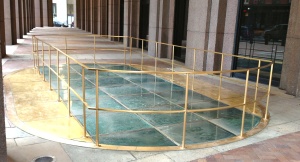 In 1979, financial giant Goldman Sachs had plans for new headquarters at 85 Broad Street.
In 1979, financial giant Goldman Sachs had plans for new headquarters at 85 Broad Street.
Nothing unusual about that—except that 300 years earlier, this address was the location of New Amsterdam’s first city hall, or Stadt Huys (“city house”), built in 1641.
Considering the possibility of uncovering historical remnants, archeologists excavated the site before construction began.
They didn’t find anything related to the Stadt Huys. Instead, they uncovered something that harkens back to the city’s beer-drinking past: the remains of a tavern built next door in 1670.
This was the Lovelace Tavern, once on the water’s edge and named for English governor Francis Lovelace, who presided over the now British-controlled city from 1668 to 1673.
The Lovelace Tavern (probably the little annex on the left in this illustration) even assumed the role of New York’s City Hall from 1697 to 1706, after which it burned down and all traces of it disappeared.
 Archeologists came across some fascinating remains. Besides the tavern’s foundation walls and floor, they discovered thousands of pieces of clay pipes, wine glasses, and wine bottles (empty, unfortunately).
Archeologists came across some fascinating remains. Besides the tavern’s foundation walls and floor, they discovered thousands of pieces of clay pipes, wine glasses, and wine bottles (empty, unfortunately).
I’m not sure where the pipes and bottles are, but the tavern’s foundation walls were preserved and are actually on view beneath a Plexiglass cover on the plaza of the building.
This Flickr photo gives the clearest view of what remains of the Lovelace. If only those tavern walls could talk. . . .
Tags: 85 Broad Street, Archeology in New York City, Colonial New York City, Dutch New York, Lovelace Tavern, lower Manhattan history, old New York taverns, Stadt Huys New York
January 31, 2013 at 4:25 pm |
Hi, great story, small correction, Stadt Huys means city house in Dutch, the Dutch word for state is “staat”.
Eric
January 31, 2013 at 4:31 pm |
Ah, thanks, I’ll make the correction!
February 1, 2013 at 12:14 am |
I love this! Thanks for the post.
February 1, 2013 at 2:48 pm |
Great post, with fantastic links! I want to take the walking tour described in the Archaeology article… definitely saving it for my next trip to NYC.
February 10, 2013 at 1:21 am |
It’s lovely that the remains were not only preserved, but now on-view. Thanks for that, Goldman Sachs.
March 6, 2017 at 6:30 am |
[…] culture is so ingrained here, a tavern functioned as the colony’s makeshift city hall through the end of the […]
April 13, 2017 at 6:18 pm |
“Raiders of a Lost City” article was so wonderful! Just knowing that these artifacts were excavated, not destroyed, makes me very, very happy. Only sour note; that excavated ship’s hull at 175 Water St. has been removed. Why? I remember peering down and marveling at the romance of seeing something intact from the 1700s. I wish that ship’s portion would be returned to it’s burial site at 175 Water St.
December 28, 2020 at 9:39 pm |
The artifacts are now owned by NYC, and are likely stored by urban archaeologist, Amanda Sutphin,in the Nan A. Rothschild Research Center of the New York City Archaeological Repository. The underground facility houses over a million objects collected from excavations throughout the five boroughs. The repository is located in the basement of the Durst Organization Building on Corporate Row. Wish I knew for certain. The other likely place is the N-Y Historical Society on CPW and 79 Street.